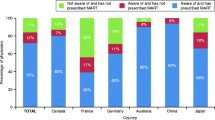Abstract
Background: Electronic implementation of questionnaires has many advantages, but there may be concerns that it alters versions that were validated on paper. Objective: To determine whether electronic implementation alters responses to the SF-36 and asthma quality of life questionnaire (AQLQ), compared to paper implementation. Methods: Patients with asthma presenting to a pneumologist were asked for consent to participate. Each patient completed both forms of each questionnaire. The order of presentation was alternated sequentially, with the first patient completing the electronic version first. Each patient waited at least 2 hours between completions to minimize recollection of answers. For both the SF-36 and AQLQ, intraclass correlations coefficients were calculated to compare patients' scores, for each scale and overall, on the electronic and paper versions. Results: Sixty-eight patients (mean age: 48 years, 50 females) of 311 contacted were enrolled. Overall intraclass correlation coefficients for the SF-36 and AQLQ were excellent (0.965 and 0.991 respectively). For paper versions, eight questions (AQLQ) and 24 (SF-36) were left blank and nine questions (SF-36) were answered incorrectly by patients selecting more than one answer. Electronic data for one patient could not be retrieved. Conclusion: Collecting SF-36 and AQLQ data electronically can decrease the number of spoiled responses without altering the results. Successful implementation depends on proper instruction of the respondent in the handling of the electronic instrument.
Similar content being viewed by others
References
Jain P, Golish JA. Clinical management of asthma in the 1990s: Current therapy and new directions. Drugs 1996; 52:(Suppl.): 1–11.
Juniper EF, Johnston PR, Borkhoff CM, et al. Quality of life in asthma clinical trials: Comparison of salmeterol and salbutamol. Am J Respir Crit Care Med 1995; 151: 66–70.
Palmer JBD, Hyland ME. Salmeterol in clinical practice: Comparator and safety studies, quality of life studies. Europ Respir Rev 1991; 1: 301–303.
Okamoto LJ, Noonan M, DeBoisblanc BP, et al. Fluticasone propionate improves quality of life in patients with asthma requiring oral corticosteroids. Ann Allergy Asthma Immunol 1996; 76(5): 455–461.
Ware JE, Sherbourne CD. The MOS 36–item Short-form Health Survey (SF-36). I. Conceptual framework and item selection. Med Care 1992; 30: 473–483.
Ware JE, Snow KK, Kosinski M, et al. SF-36 Health Survey: Manual and Interpretation Guide. Boston: Nimrod Press, 1993.
Juniper EF, Guyatt GH, Epstein RS, et al. Evaluation of impairment of health-related quality of life in asthma: Development of a questionnaire for use in clinical trials. Thorax 1992; 47: 76–83.
Juniper EF. Quality-of-life considerations in the treatment of asthma. Pharmacoeconomics 1995; 8(2): 123–138.
Juniper EF, Guyatt GH, Ferrie PJ, et al. Measuring quality of life in asthma. Am Rev Respir Dis 1993; 147: 832–838.
Rutten-van Mölken MPMH, Custers F, Van Doorslaer EKA, et al. Comparison of performance of four instruments in evaluating the effects of salmeterol on asthma quality of life. Euro Respir J 1995; 8: 888–898.
Juniper EF, Guyatt GH, Feeny DH, et al. Minimum skills required by children to complete health-related quality of life instruments for asthma: Comparison of measurement properties. Eur Respir J 1997; 10: 2285–2294.
Lundström S. Electronic patient diaries. Appl Clin Trials 1993; 2: 35–38.
Zogg W, Koch U, Holsboer E, Hemmeter U, et al. Clinician's assessments and patient's self-ratings by computer: A feasibility study with the antidepressant paroxetine. Brit J Clin Research 1993; 4: 211–218.
Nived O, Sturfelt G, Eckernäs S-A, et al. Comparison of 6 month's compliance of patients with rheumatoid arthritis treated with tenoxicam and naproxen. Use of patient computer data to assess response to treatment. J Rheumatology 1994; 21: 1537–1541.
Van Gerven JMA, Shoemaker RC, Jacobs LD, et al. Self-medication of a single headache episode with ketoprofen, ibuprofen or placebo, home-monitored with an electronic patient diary. Brit J Clin Pharmacology 1996; 42: 475–481.
Lin M, Ward JE. Reliability of the MOS SF36 health status measure in Australian general practice. Aust Fam Physician 1998; 27(Suppl 2): S94–S98.
Andresen EM, Bowley N, Rothenberg BM, et al. Test-retest performance of a mailed version of the Medical Outcomes Study 36–item Short-Form Health Survey among older adults. Med Care 1996; 34(12): 1165–1170.
Burke JD, Burke KC, Baker JH, et al. Test-retest reliability in psychiatric patients of the SF-36 health survey. Int J Meth Psychiatric Res 1995; 5: 189–194.
Drummond HE, Ghosh S, Ferguson A, et al. Electronic quality of life questionnaires: A comparison of pen-based electronic questionnaires with conventional paper in a gastrointestinal study. Qual Life Res 1995; 4: 21–26.
McBride JS, Anderson RT, Bahnson JL. Using a hand-held computer to collect data in an orthopedic outpatient clinic; a randomized trial of two survey methods. Med Care 1999; 37(7): 647–651.
Murrelle L, Ainsworth BE, Bulger JD, et al. Computerized mental health risk appraisal for college students: User acceptability and correlation with standard pencil-and-paper questionnaires. Amer J Health Promotion 1992; 7(2): 90–92.
Pouwer F, Snoek FJ, van der Ploeg HM, et al. A comparison of the standard and the computerized versions of the Well-Being Questionnaire (WBQ) and the Diabetes Treatment Satisfaction Questionnaire (DTSQ). Qual Life Res 1998; 7: 33–38.
Author information
Authors and Affiliations
Rights and permissions
About this article
Cite this article
Caro Sr, J., Caro, I., Caro, J. et al. Does electronic implementation of questionnaires used in asthma alter responses compared to paper implementation?. Qual Life Res 10, 683–691 (2001). https://doi.org/10.1023/A:1013811109820
Issue Date:
DOI: https://doi.org/10.1023/A:1013811109820




